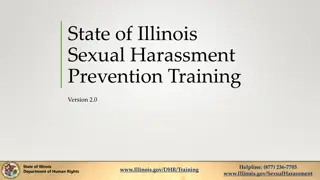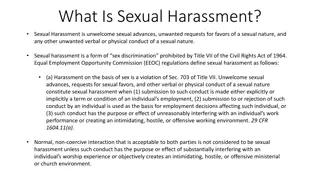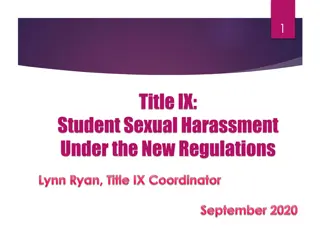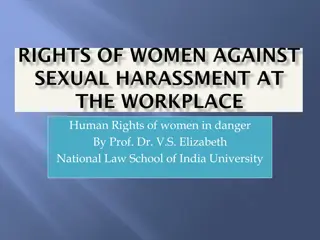Understanding Sexual Harassment and Title IX Regulations
Explore the essentials of Title IX regulations, sexual harassment, and the critical role of the Title IX Coordinator. Learn about the new 2020 regulations, reporting requirements, and the significance of compliance training for all employees.
Download Presentation

Please find below an Image/Link to download the presentation.
The content on the website is provided AS IS for your information and personal use only. It may not be sold, licensed, or shared on other websites without obtaining consent from the author. Download presentation by click this link. If you encounter any issues during the download, it is possible that the publisher has removed the file from their server.
E N D
Presentation Transcript
What All Employees Need to Know about Sexual Harassment and the New Title IX Regulations
What is Title IX? Title IX of the Education Amendments of 1972 prohibits discrimination based on sex in educational institutions that receive federal financial assistance. Title IX has just 37 words. No person in the United States shall, on the basis of sex, be excluded from participation in, be denied the benefits of, or be subjected to discrimination under any education program or activity receiving Federal Financial Assistance.
Sexual Harassment and Title IX Harassment based on sex, or sexual harassment, is a form of discrimination based on sex that violates Title IX. This has been established in the law for a long time. For employees, sexual harassment is also prohibited under Title VII of the Civil Rights Act. But specific federal guidance on compliance with that law has been limited, until now.
2020 Title IX Regulations New Title IX regulations from the US Department of Education became effective on August 14, 2020. These rules significantly expand and change the role and responsibilities of all staff with respect to allegations of sexual harassment. While the Title IX Coordinator coordinates the district s efforts to comply with Title IX, this session will outline the key provisions of the regulations and emphasize the practical implications for all district employees. 4
Role of Title IX Coordinator Every district must have at least one, and that person must be designated and identified as the Title IX Coordinator. Must have authority to coordinate the school district s compliance efforts. Must be referred to as the Title IX Coordinator in district policies and publications, including website. All potential reporters of sexual misconduct must be notified of the Title IX Coordinator s contact information: name/title, office and email addresses, and telephone number. All potential reporters That is generally on a district s website or in policy or both. 5
Actual Knowledge Because under the new Title IX regulations, ANY who knows that an employee or a student is being sexually harassed MUST REPORT MUST REPORT or else the District AND the Employee District AND the Employee face potential legal liability. ANY district employee
Sexual Harassment & Title IX: Be Familiar With the New Terms 8
Not all Sexual Misconduct in Schools is Sexual Harassment Under Title IX The Title IX regulations set out three types of conduct on the basis of sex that constitutes sexual harassment: Quid pro quo by an employee Hostile environment: Unwelcome conduct that is so severe, pervasive and objectively offensive that it effectively denies the person access to an education program or activity. Conduct that meets the definition for sexual assault, dating violence, domestic violence, and stalking under federal law.
Quid Pro Quo Sexual Harassment Quid pro quo: When an employee conditions favorable treatment on the acceptance of unwelcome sexual attention. This definition applies only to actions of employees. Teacher offers good grades to student in exchange for .. Maintenance Director offers a promotion or better pay in exchange for ..
Hostile Environment Sexual Harassment Conduct that it is so severe, pervasive, AND effectively denies a person equal access to the school s programs. AND objectively offensive that it This could be student-to-student conduct, employee-to-student conduct, or employee-to-employee conduct. You may not be sure if the conducted observed or reported to you meets this standard, but err on the side of caution and report.
Four More Types of Sexual Harassment These are all criminal conduct that should be reported to law enforcement or CYFD: Sexual assault: Forcible or non-forcible sexual offenses under the Uniform Crime Reporting System of the FBI. Dating violence: Violence done by a person who is, or has been, in a dating relationship with the other person. Domestic violence: Violence by a current or former intimate partner. Stalking: A course of conduct directed at a specific person that would cause a reasonable person to fear for personal safety of self or others; or to suffer emotional distress.
Other New Terms: Complainant and Respondent Complainant Complainant = individual who has been allegedly sexually harassed Respondent Respondent = person accused of sexual harassment 13
Formal Complaint vs. Report Formal Complaint: Formal Complaint: written document and process initiated by the Complainant or the Title IX Coordinator Report: Report: is verbal or written, by anyone VS. VS. 14
The Report 15
Reporting and Responding ALL employees must report when they learn of or see potential sexual misconduct. Not just the alleged victim. A report can be verbal or written. Reports can be made by mail, telephone, or email at any time (business or non-business hours) to the Title IX Coordinator or any district administrator. Your district may have established a reporting system. The T9C may also receive a report from an employee of an elementary or secondary school who receives notice of sexual harassment or alleged sexual harassment: what we would consider actual knowledge actual knowledge. . If the district has actual knowledge of sexual harassment it must respond promptly in a manner that is not deliberately indifferent. 16
Deliberate Indifference & Actual Knowledge Deliberate indifference means to act in a way that is clearly unreasonable given the known circumstances. This can include failure to report, failure to investigate and correct known harassment, or failure to adequately discipline the harasser. When any district employee has notice of sexual harassment or alleged sexual harassment, that employee has what the law called alleged sexual harassment, that employee has what the law called actual knowledge. actual knowledge. When any district employee has notice of sexual harassment or When the district has actual knowledge of sexual harassment it must respond promptly in a manner that is not deliberately indifferent. Failure to do so, can result in liability, both for the district and the employee. 17
Timeliness Although reports of sexual harassment should be made in a timely manner, unlike other district grievances, a sexual harassment complaint can be made as long as the Complainant and Respondent are both still enrolled in/employed by the district or are the beneficiaries of the district s programs. So even if the events occurred months ago, the conduct must be reported and investigated under the new Title IX rules, if it occurred after August 2020. (alleged sexual harassment prior to then must be investigated and addressed, but not using the new procedures) 18
Retaliation Retaliation is prohibited against any individual who wishes to or has made a complaint or has been involved with a Title IX investigation. 19
Other State Reporting Requirements This presentation is specific to Title IX, but do not forget about other reporting requirements, including mandatory reporting requirements for child abuse/neglect, other potential criminal conduct. 20
Scenarios 21
Scenario 1: Scenario 1: A paraprofessional tells a teacher that she was offered a promotion by the principal in return for a backrub during a school-sponsored team building retreat. 22
This is quid pro quo sexual harassment This is quid pro quo sexual harassment as defined by Title IX. The teacher as defined by Title IX. The teacher should report this to the Title IX should report this to the Title IX Coordinator who will promptly reach out Coordinator who will promptly reach out to the paraprofessional. to the paraprofessional. 23
Scenario 2: Scenario 2: A senior high school student confides in his good friend, the lunch lady as she s affectionately known, that his girlfriend, a fellow student at the same high school, punches him in the groin at football games when he looks at the cheerleaders. They have been to every football game this season and he looks at the cheerleaders at least once a game (by accident). It s hard for him to watch the games after getting punched. Student is adamant he does not want to file a complaint. 24
The food service employee must report this information to the Title IX Coordinator who will reach out to the student. His wishes that it not be reported will be addressed by the Title IX Coordinator, they do not mean the reporting obligations are relieved. 25
Remember! 26
Investigating Alleged Sexual Harassment An employee who receives a report of information that might be sexual harassment should report all known information to the Title IX Coordinator or to a district administrator. That employee does NOT attempt to investigate or take disciplinary measures. Those responsibilities fall to the Title IX Coordinator. 27
Set The Right Tone We have liability under the law when sexual misconduct is unaddressed. The way we keep things from getting really bad is to address minor incidents that occur along the way. Make sure that all staff teachers, coaches, bus drivers, custodians, food service staff who have regular interaction with students are setting the right tone, being good role models, and being attentive to student conduct. 28























